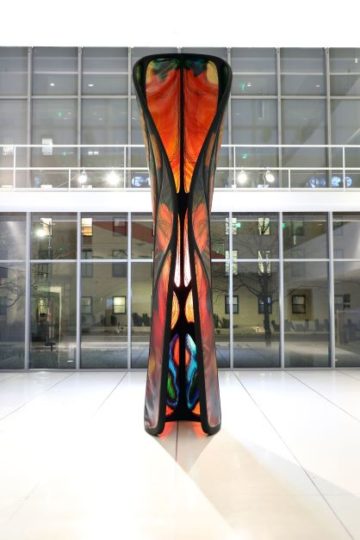
Originally published in the Marina Times San Francisco in February 2022
SFMOMA’s new exhibit features sustainable architectural ideas for the 21st century. Oxman Architects addresses what it means to build, house, inform and inspire eco-friendly models of living via forty thought provoking artworks and installations. The work rethinks models of lifestyle and design with an objective to move from a focus on material wealth to a focus on environmental health. With never-before -seen large-scale projects, the presentation celebrates Oxman’s pioneering approach to the future.
Sustainability and Style
Oxman Architects create the essential objects that house and design humanity through a lens of environmental responsibility. Wearables, construction and fabrication are reinvented using materials that can decay naturally when no longer needed. The Aguahoja pavilions will be on display – one in pristine, newborn condition and another undergoing programmed decomposition. Both are made from discarded shells of ocean crustaceans, fallen leaves and apple skins as building material. The richly colored fluid shapes of the pavilions gradually decay, thereby enriching the soil with nutrients for new growth.
The Wanderers series is a collection of wearables for outer space. The designs including Otaared wearable for Mercury and Quamar wearable for the moon bring a physical and visual fascination that feels straight out of a science fiction film. Vessels created for living organisms respond to extreme conditions on specific planets, such as 200-degree temperature fluctuations, high meteor activity, or changes from extreme brightness to darkness that affect visibility.
Totem presents another exploration related to light and darkness. Melanin, a naturally occurring pigment, can be added to a transparent building material to provide shade when the sun is at its brightest, and fade back to transparent when the sun sets. The Biodiversity Pavilion for Table Mountain National Park in Cape Town, South Africa is a design for a pavilion made of such responsive material, reducing the need for additional cladding.
The Vespers takes on the topic of death and burial, and the methods societies use to remember departed loved ones. Designs consider new ways to memorialize the departed, from mapping their external features to capturing their final breath and retaining it as a dynamic visualization. Using 21st century technology, these jewel-like organic shapes as symbolic artifacts challenge us to embrace alternate methods for honoring the deceased in ways that have minimal impact on the Earth.
Looking Toward the Future
The Future of Mannahatta imagines Manhattan in 2100 and 2200, respectively, as the rising tides and heat hazards from climate change influence the precarious state of urban landscapes, specifically where developed land meets surrounding water. In this plan, existing structures are replaced with urban design which reestablishes a healthy ecosystem. The new structures restore the balance between nature and humanity in an attempt to adapt to and correct aspects of global warming.
“While human material wealth stakes claim to land and resources, environmental health restores and advances natural balance to mutually benefit all. OXMAN’s radical perspective lies in its ability to envision an alternative architectural legacy upending a human-centered built environment to reprioritize nature,” said Jennifer Dunlop Fletcher, SFMOMA’s Helen Hilton Raiser Curator of Architecture and Design.
Questioning Tradition
Founder and CEO of OXMAN, Neri Oxman, was born in 1976 in Haifa, Israel and is based in New York City. She was a tenured professor at the Massachusetts Institute of Technology (MIT), where she founded and directed The Mediated Matter Group, a lab that conducted research at the intersection of computational design, digital fabrication, materials science and synthetic biology. While at MIT she pioneered the field of Material Ecology, which studies relationships and interactions between designed objects, their structures and environs. The approaches are intended for the future of architecture, product design and biotechnology as well as the design of new tools for digital fabrication and construction.
Additional Programs
SFMOMA will co-present, along with the Long Now Foundation, an evening of conversation with the Architect and artist Neri Oxman on Wednesday, February 16th at 7pm in the Herbst Theater. Working at the intersection of technology and biology, Oxman calls for a fundamental shift in design. She will discuss her projects with OXMAN, a design practice uniting science and engineering, art, design and history where she continues to construct environments in better alignment with principles of ecology.